Apollo
-
- Incinerator Ship Apollo One Launched At Tacoma Boatbuilding Maritime Reporter, Apr 1984 #20
The Apollo One, first oceangoing hazardous waste incinerator ship designed and built in the U.S., was launched at the Tacoma Boatbuilding Company's Yard No. 3 in Tacoma, Wash., recently. The $37- million vessel and a sister ship, the Apollo Two, are being constructed for At-Sea Incineration, Inc. (ASI) of Port Newark, N.J., a wholly owned subsidiary of Tacoma Boat.
Built with the aid of Federal Title XI loan guarantees, these ships have been designed to meet all existing environmental and safety standards of the U.S. Coast Guard, the Environmental Protection Agency, the Maritime Administration, and the National Bureau of Standards, among others, and are the first of their kind to meet the criteria of the American Bureau of Shipping.
The Apollo One can safely destroy up to 30 million gallons of hazardous waste each year. She is the first in a fleet of ships that ASI will operate at Federally approved ocean burn sites. The currently approved site is in the Gulf of Mexico near Cameron, La.; the other, whose approval is expected shortly, is in the Atlantic Ocean.
Both are 150-200 miles out at sea.
To support the burning of hazardous waste materials at sea, ASI will operate a multi-million-dollar marine transfer terminal near each of the burn sites. These commercial terminals will collect, test, blend, and temporarily store a variety of hazardous waste materials prior to transferring them to the incineration ships for disposal.
The launch of Apollo One culminates years of cooperative effort among international regulatory agencies, the Federal Government, and private industry to develop an environmentally acceptable alternative to the inadequate and often dangerous hazardous waste disposal methods of the past.
Classed by the American Bureau of Shipping as + A1 E Chemical Carrier, +AMS, +ACCU, + IS, the Apollo One is designed with accommodations forward, chemical waste cargo tanks amidships, and propulsion and incineration machinery aft. A forecastle deck is provided forward and a poop deck aft.
Twelve integral cargo tanks are located to comply with requirements for a Type II cargo containment system. A pipe trunk is provided on center line throughout the length of the cargo space and from the inner bottom to the main deck. Transverse cofferdams are installed between cargo tanks.
Ballast tanks are located outboard of the cargo tanks, in the double bottom space, and deep tanks for- ward and aft. Fuel oil tanks are provided aft and fresh water tanks forward.
The vessel has an overall length of 396 feet, molded beam of 60 feet, molded depth of 31 feet, and design full-load draft of 23 feet 6 inches. Deadweight a full-load draft is 7,317 tons. Liquid cargo capacity (100 percent full) is 197,730 cubic feet. Accommodations, berthing, messing, and lounges are provided forward for a total complement of 25 persons. The wheelhouse and radio rooms are also forward. A cargo pump room is located aft of the cargo space, with access to the main deck. Two Flume stabilization tanks are fitted above the cargo pump room.
Two liquid waste incinerators are installed on the poop deck aft of and above the propulsion and auxiliary machinery space. An incinerator forced-draft fan room is provided immediately below the incinerators. A central control room is located forward of the incinerator room for monitoring and controlling all cargo handling and waste incineration processes and well as centralized control of propulsion and auxiliary machinery.
Main propulsion is provided by twin Caterpillar D399T, 16-cylinder, 4-stroke diesel engines, each rated 1,125 bhp at 1,225 rpm. The engines drive Columbian Bronze fixed-pitch propellers through Caterpillar reverse/reduction gears.
Engine controls (ACCU) were supplied by General Electric. A Bird- Johnson bow thruster is provided, powered by a GE 400-hp motor.
Two auxiliary generators are also driven by Caterpillar D399T diesels.
-
- Hydranautics Provides Skidding Systems For Jackups Apollo III, IV Maritime Reporter, Oct 1981 #46
Hydraulic Systems, Goleta, Calif., completed shipment recently of the skidding systems contracted by Western Oceanic, Inc., Houston, Texas, for use on Apollo III and IV. The Friede & Goldman designed L780 cantilever, self-elevating offshore drilling units are being built by China Shipbuilding Corp.,
-
- Shipping Executive Focus: Art Regan, Executive Chairman, Genco Shipping & Trading Maritime Reporter, Aug 2018 #70
of another wave of fresh capital into shipping - the inflow of financial investors, notably packagers of private equity funds. In 2010, Regan moved over to Apollo Global Management, where he launched their ship management and advisory entity, Principal Maritime, which serviced maritime investment holdings in
-
- MTR100: Editor’s Choice - Five Stand-Outs Marine Technology, Aug 2015 #50
. All these qualities have brought them success in their four divisions: Communications, Oceanographic Asset Recovery, Remote Monitoring and Security. The Apollo is an independently powered, self-contained mooring beacon with the power of an ultra-bright LED Flasher combined with satellite communications. Users
-
- Canter Named President Of At-Sea Incineration Maritime Reporter, Sep 1984 #19
designed incineration ships at federally approved ocean burn sites. In February this year, the first Americanbuilt, high-efficiency incineration ship, Apollo I, was launched by her designer and builder, Tacoma Boatbuilding. The ship will be chartered by Apollo Company LP, a New York limited partnership
-
- FELS To Construct Semisubmersible Rig For Western Company Maritime Reporter, Jun 1981 #9
currently under construction in FELS, will be among the first jackups of this design to be operational in the world. They will be christened Apollo I and Apollo II
-
- OUTSTANDING OCEANGOING SHIPS OF 1984 Maritime Reporter, Dec 1984 #12
for a crew of 22 are provided. Strengthened for carriage of heavy cargoes, the ship is classed by Lloyd's Register of Shipping + 100 Al. APOLLO ONE Tacoma Boatbuilding The Apollo One, first oceangoing hazardous waste incinerator ship designed and built in the U.S., was launched at the
-
- AK-WA Converts Incinerator Ship, Wins Contract To Modernize LCMs And Rebuilds Fishing Vessel Maritime Reporter, Feb 1991 #8
AK-WA Shipyard, Tacoma, Wash., is converting the 369-foot Apollo One to a bottom fish processor for an early March delivery to the Seattle-based Dona Fisheries. In addition, the yard won a contract to repower and modernize eight LCMs. The Apollo One, launched in 1984 as an incinerator ship for
-
- David Clark Company: An American Success Story Marine News, Aug 2023 #22
,200 feet.Gemini Space Suits developed for each mission's unique requirements, including the G-4C space suit for Ed White's first U.S. space walk.Apollo Block I Suits utilized to train the initial Apollo astronaut crews and support initial missions.Apollo Communications Carrier worn by all Apollo astronauts
-
- New Fire Detection System Maritime Reporter, Mar 2014 #57
Elite RSM Analog Addressable Fire Alarm Control Panels are designed to accommodate up to 256 devices on Commercial Marine Applications. Apollo protocol USCG / ABS Type Approved Smoke and Heat Detectors are available for a complete approved system. Two full SLC loops and leading edge microprocessor based
-
- Fire Detection from Fireboy-Xintex Maritime Reporter, Oct 2013 #70
part of larger systems. Elite RSM Control Panels are simple and easy to understand for installers, commissioning personnel and vessel owners and feature Apollo protocol smoke and heat detectors. Two full SLC loops and leading edge microprocessor based electronics are also standard. www.fireboy-xintex.com (A
-
- Reno Spiteri Opens O f f i c e In M a l t a Maritime Reporter, Dec 15, 1978 #23
manager with Malta Drydocks, and as engineer and fleet superintendent to Sea Malta Company Ltd. Marine Surveys & Services Bureau is located at 4 Apollo Court, Dome Str., Fgura, Malt
-
 )
June 2025 - Maritime Reporter and Engineering News page: 15
)
June 2025 - Maritime Reporter and Engineering News page: 15million. ustoMSC P10000 Deepwater Champion is valued between $144 and $159 million, and Samsung 12000 Ocean Rig Mylos, Ocean Rig Athena and Ocean Rig Apollo are valued between $165 and $185 million. With recycling most likely not a viable option, Transocean is left with the expensive option of reactivation
-
 )
May 2024 - Maritime Reporter and Engineering News page: 48
)
May 2024 - Maritime Reporter and Engineering News page: 48missile-range instrumentation ship to support space speed “expeditionary fast transports” to move people, vehicles ? ight tracking, including the Apollo and Skylab programs. She and cargo quickly around a theater of operations. brie? y carried the name Muscle Shoals (T-AGM-19) before be- Looking
-
 )
November 2023 - Marine News page: 27
)
November 2023 - Marine News page: 273156Es, putting out 7,000 hp) for ship assist and christened its Green Diamond, which it described as “… escort work. Earlier, sister vessels Athena, Apollo and Her- the nation’s ? rst plug-in hybrid electric inland towing ves- cules had been delivered to Crowley under similar arrange- sel,” with battery
-
 )
August 2023 - Marine News page: 24
)
August 2023 - Marine News page: 24Feature Comms • Apollo Communications Carrier worn by all Apollo of 2012, Baumgartner jumped from a capsule 128,000 feet astronauts on lunar missions, providing clear and reliable above earth (at that time a world record), suspended in space communications with mission control on Earth. by a balloon.
-
 )
August 2023 - Marine News page: 23
)
August 2023 - Marine News page: 23Undeterred, David Clark persevered. After experiment- Ed White’s ? rst U.S. space walk. ing with several suit pressure valve and in? atable bladder • Apollo Block I Suits utilized to train the initial Apol- designs, the company received its ? rst check from the gov- lo astronaut crews and support initial
-
 )
October 2022 - Marine News page: 76
)
October 2022 - Marine News page: 76...................................................................56 Marine Group Boat Works ............................................................36 Apollo Global Management ..........................................................22 Marine Jet Power ..................................................
-
 )
October 2022 - Marine News page: 23
)
October 2022 - Marine News page: 23BARRY PARKER (backed by Italian renewables specialist Renexia SpA, with (and, ultimately, routine operations). Codi? ed law (along participation from Apollo Global Management), off the with regulatory rulings) related to the Jones Act, which Maryland coast. Following up on multiple leases awarded requires
-
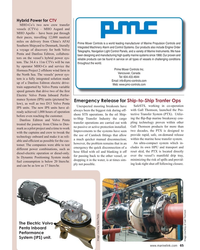 )
November 2021 - Maritime Reporter and Engineering News page: 65
)
November 2021 - Maritime Reporter and Engineering News page: 65Hybrid Power for CTV MHO-Co’s two new crew transfer vessels (CTVs) – MHO Asgard and MHO Apollo – have been put through their paces, travelling 12,000 nautical miles on delivery from China’s AFAI Prime Mover Controls is a world leading manufacturer of Marine Propulsion Controls and Southern Shipyard to
-
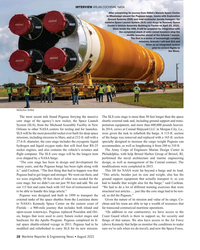 )
August 2021 - Maritime Reporter and Engineering News page: 28
)
August 2021 - Maritime Reporter and Engineering News page: 28access to the on, barges that were used to carry Saturn rocket stages and Coast Guard which is there to support us, for security and hardware for the Apollo Program. Pegasus completed its ? - things of that nature. We also have access to the Air Force nal space shuttle-related voyage in 2011. Pegasus
-
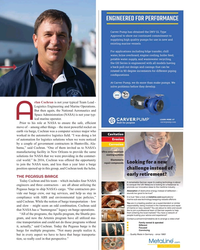 )
August 2021 - Maritime Reporter and Engineering News page: 27
)
August 2021 - Maritime Reporter and Engineering News page: 27operations. like to join a professional team of German experts to help them entering the local markets? You have a network of “All of the programs, the Apollo program, the Shuttle pro- people trusting your advice and experience? gram, and now the Artemis program have all utilized ma- Contact p.schramm@metaline
-
 )
October 2019 - Marine Technology Reporter page: 13
)
October 2019 - Marine Technology Reporter page: 13carbonizing electricity, vehicles and over 10 years and leveraging an ad- buildings. She proposes: ditional $5 trillion in local, state and • A “Green Apollo” plan – invest- private sector investments resulting in ing $400 billion in 10 years in R&D. a “100% clean energy economy and • “Green Manufacturing”
-
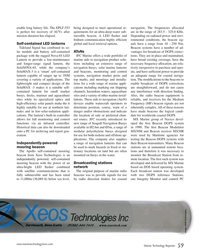 )
May 2019 - Marine Technology Reporter page: 59
)
May 2019 - Marine Technology Reporter page: 59that can their Beacon transmitters. Many Beacon mooring beacon be used to mark hazards in ? xed or sta- stations are at unmanned remote loca- The Apollo self-contained mooring tionary locations on land but are often tions and therefore it was necessary to beacon from Xeos Technologies is an mounted
-
 )
May 2019 - Marine Technology Reporter page: 58
)
May 2019 - Marine Technology Reporter page: 58sign uses an ultra-low power electronics Vehicle (AUV) operations, enabling image quality is critical. and water turn-on sense circuitry which The Apollo self- contained mooring beacon from Xeos Technologies Inc is an independently pow- ered, self-contained mooring beacon that is fully submersible
-
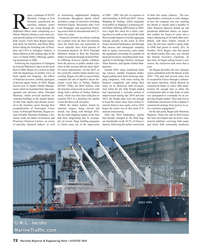 )
August 2018 - Maritime Reporter and Engineering News page: 72
)
August 2018 - Maritime Reporter and Engineering News page: 72supplemental shipping of 2004 – 2007, but also in response to of debt into equity (shares). The new Maritime College at Fort investments throughout Apollo which mini-boomlets in 2010 and 2013. Genco shareholders continued to seek changes Schuyler, commenced his included a range of structures including
-
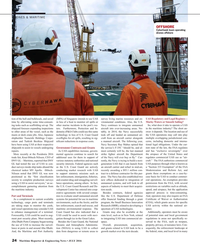 )
July 2016 - Maritime Reporter and Engineering News page: 24
)
July 2016 - Maritime Reporter and Engineering News page: 24aboard the as the U.S. Coast Guard are actively an aircraft carrier and refuel in mid-air, a “Section 333 Exemption” of the FAA chemical tanker MV Apollo. Ørbeck- conducting market research with UAS recently awarding a $93.1 million con- Modernization and Reform Act, and Nilssen noted that DNV GL
-
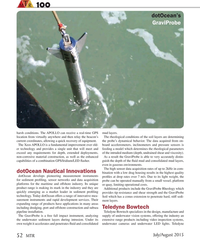 )
July 2015 - Marine Technology Reporter page: 52
)
July 2015 - Marine Technology Reporter page: 52T M R 100100 dotOcean’s GraviProbe harsh conditions. The APOLLO can receive a real-time GPS mud layers. location from virtually anywhere and then relay the beacon’s The rheological conditions of the soil layers are determining current coordinates, allowing a quick recovery of equipment. the probe’s
-
 )
July 2015 - Marine Technology Reporter page: 51
)
July 2015 - Marine Technology Reporter page: 51“Coordinated Robotics” project, which was also featured in Remote Monitoring and Security. June 2015 issue. The goal was to expand techniques for ef- The Apollo is an independently powered, self-contained ? ciently coordinating deployments of multiple exploratory mooring beacon with the power of an ultra-bright
-
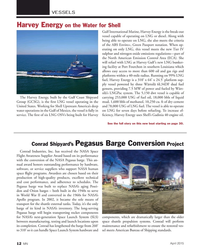 )
April 2015 - Marine News page: 12
)
April 2015 - Marine News page: 12was built to replace NASA’s aging Posei- don and Orion barges – both built in the 1940s to serve in World War II and converted in the 1960s for NASA’s Apollo program. In 2002, it became the sole means of transport for the shuttle external tanks. Today, it’s the only barge of its kind in NASA’s inventory
-
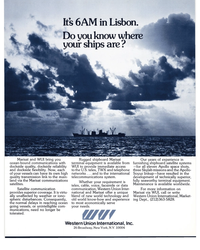 )
August 1977 - Maritime Reporter and Engineering News page: 15
)
August 1977 - Maritime Reporter and Engineering News page: 15and experience to most economically serve your needs. UJl/f Our years of experience in furnishing shipboard satellite systems —for all eleven Apollo space shots, three Skylab missions and the Apollo- Soyuz linkup—have resulted in the development of technically superior, fully seaworthy terminal
-
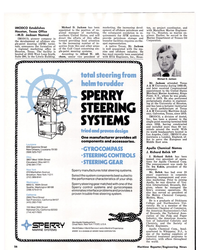 )
November 1977 - Maritime Reporter and Engineering News page: 58
)
November 1977 - Maritime Reporter and Engineering News page: 58world headquarters located in Los Angeles, Calif., IMODCO also maintains a London, England, of- fice to serve the European and Middle East area. Apollo Chemical Names J. Richard Relick VP J. Richard Relick has been named vice president of opera- tions for Apollo Chemical Corp. The announcement
-
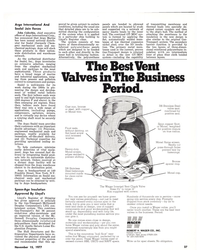 )
November 15, 1977 - Maritime Reporter and Engineering News page: 25
)
November 15, 1977 - Maritime Reporter and Engineering News page: 25and an improved version of the Mc- Donnell Douglas Corporation's three-dimensionally reinforced polyurethane foam developed for the U.S. Apollo/Saturn Lunar Ex- ploration Program. The Hull Structures and Re- frigeration Departments have re- viewed the physical strength and thermal properties
-
 )
December 15, 1978 - Maritime Reporter and Engineering News page: 27
)
December 15, 1978 - Maritime Reporter and Engineering News page: 27with Malta Dry- docks, and as engineer and fleet superintendent to Sea Malta Com- pany Ltd. Marine Surveys & Services Bu- reau is located at 4 Apollo Court, Dome Str., Fgura, Malta. Argo Names Nietsch To Pollution Control Post H. Erich Nietsch has been ap- pointed marketing manager of the
-
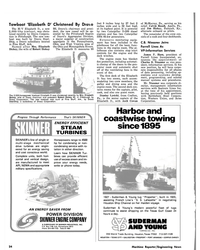 )
July 1980 - Maritime Reporter and Engineering News page: 24
)
July 1980 - Maritime Reporter and Engineering News page: 24Lysieki, from Crafton, Pa., is the senior captain of the Elizabeth D., with Arch Cowan of McMurray, Pa., serving as his relief. Calvin Roush, Apollo, Pa., and Jim Hickey, Paducah, Ky., alternate onboard as pilots. The remainder of the crew con- sists of a cook and four deckhands. C.B. Niessner
-
 )
June 1981 - Maritime Reporter and Engineering News page: 9
)
June 1981 - Maritime Reporter and Engineering News page: 9currently under construc- tion in FELS, will be among the first jackups of this design to be operational in the world. They will be christened Apollo I and Apollo II. Select the only seagoing fans with Hartzell quality Hartzell has been a leading manufacturer of high quality air moving equipment
